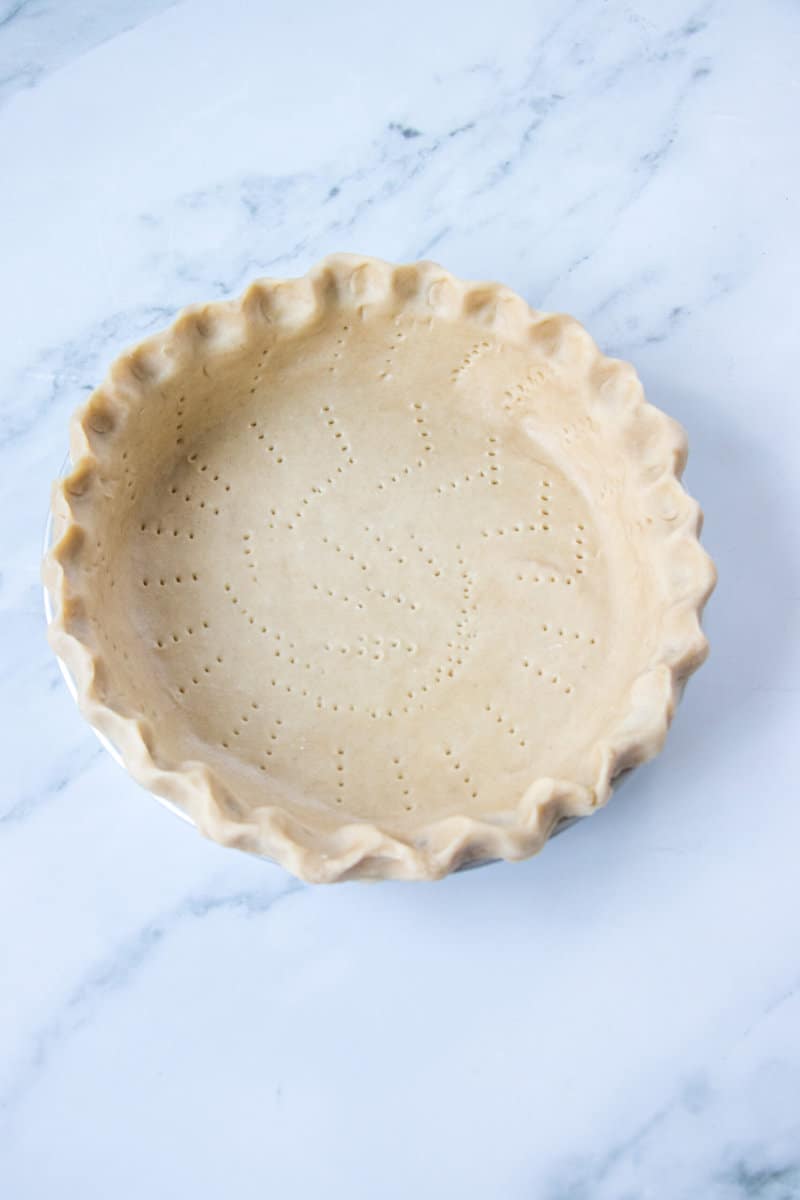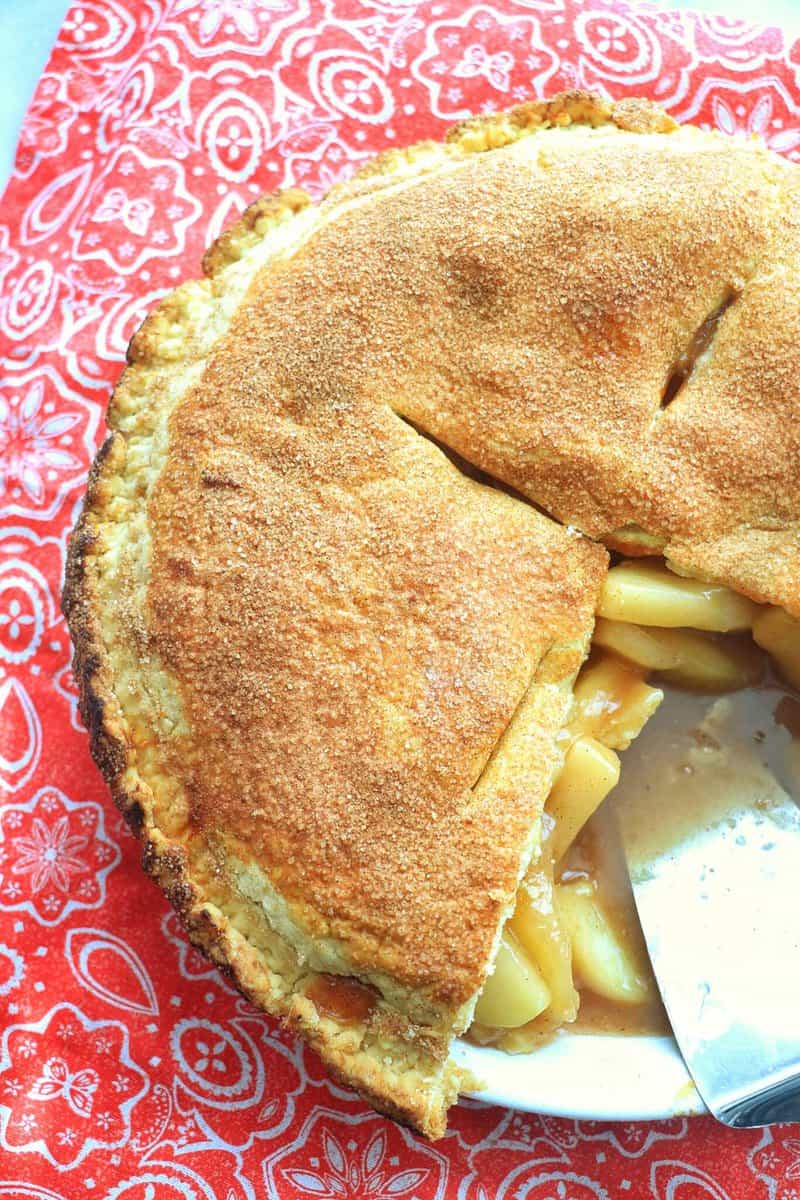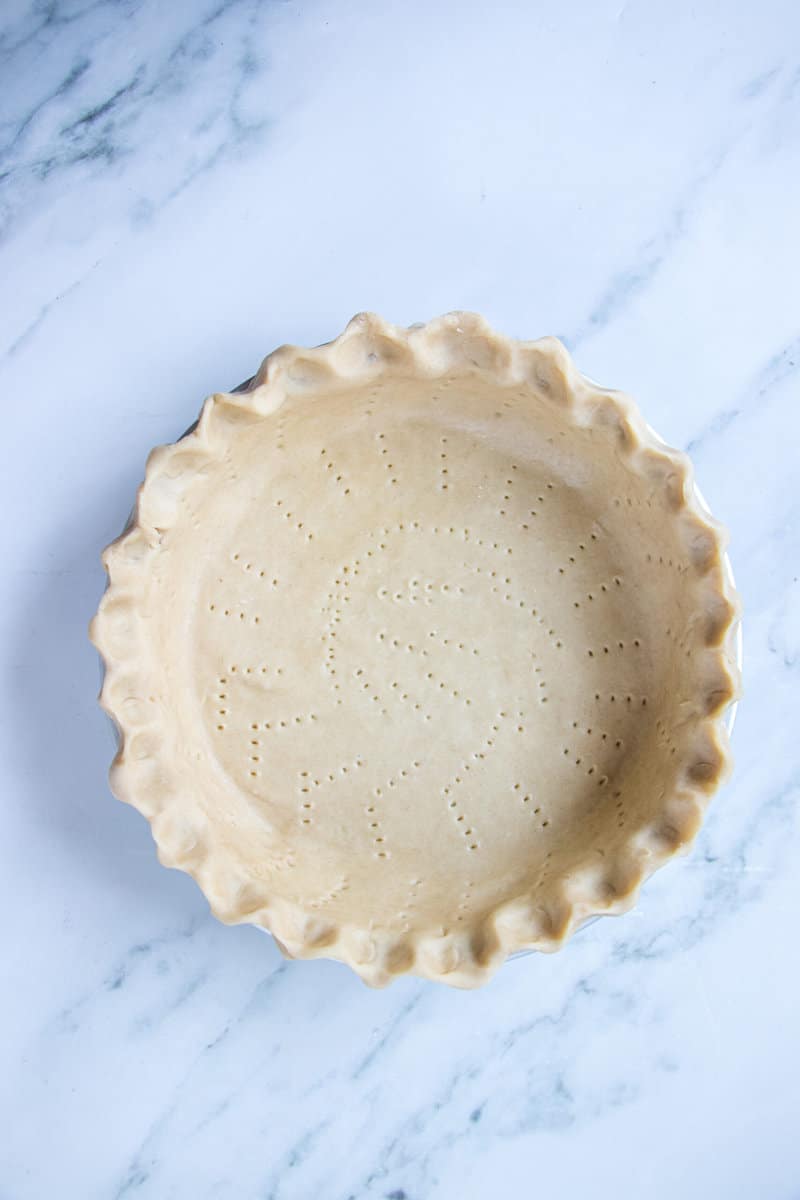This post may contain Affiliate Links. Please see my Disclaimer for more details.
This Pie Crust recipe shows how easy it is to make a single pie crust that’s tender and flaky by hand in 10 minutes.
Here are some pie recipes to use this crust with, Southern Sweet Potato Pie, Classic Apple Pie, Cherry Galette with Chocolate Port Sauce, Southern Pecan Pie, and Peach Cobbler.

Latest Recipe Video:
Jump to:
Nowadays, I find myself making pie crust with a food processor because it's so simple to toss everything in a food processor and make a pie crust. That's until it's time to do the dishes!
However, I'm a teacher that believes you shouldn't take a shortcut until you've made it the old-school way and understand everything about the dish. Having this knowledge allows you to utilize the shortcuts but get the same results as the traditional way.
Making a pie dough by hand is a lot like making biscuits. And I love biscuits. You cut the butter into the flour, add some liquid to moisten the dough, make a dough ball then form into the desired shape.
Yes, I know I just made it sound easy, and that's because making a pie crust by hand without a food processor is that easy. It doesn't matter if you're making a single pie crust recipe or a double pie crust recipe.
This pie crust recipe is all you'll need to consistently produce buttery, flaky pie crust that's perfect for cobblers, hand pies, chicken pot pies, galettes, or your favorite pie.

Key Ingredients
Here are the ingredients you'll need for your flaky pie crust.
All-Purpose Flour
Pie crust needs gluten to create layers of flaky deliciousness.
Sugar
I like making a sweet pie crust, so I add a little sugar to my crust.
Salt
A small pinch of kosher salt will wake up all the flavors.
Unsalted Butter
You want to use cold butter in your recipe. If you only have salted butter at home, use it and omit the salt in the recipe.
Shortening
A little shortening coats the flour and helps form layers of flaky crust. I only use non-hydrogenated shortening because it's not chemically processed.
Water
Cold tap water is perfect. I like to add one ice cube to the water, so it's extra cold water.
If you're going to make cranberry sauce at home, you'll need a few key ingredients.

How To Make A Flaky Pie Crust Recipe
The key to baking is the technique, patience, and confidence. That's how I will teach you to make a flaky pie crust recipe.
In a large bowl, combine flour, sugar, and salt. Add cold butter and cut fat shortening into the flour mixture with a pastry cutter or fork until it resembles coarse cornmeal with a few pea-size pieces of butter remaining.
Stir in ice water until pie dough forms (add another tablespoonful of water if needed). The flour should be loose, knead dough 3-5 times until all flour is incorporated into the dough. Flatten pie dough into a disc shape, wrap in plastic wrap and refrigerate for at least 45 minutes.
Use a rolling pin to roll out pie dough on a lightly floured surface to a 12" round. Transfer to a 9-inch pie pan. You can trim and crimp the edges with a fork, fold the extra dough under itself, and make a design. Pierce evenly with a fork, and pre-bake in a 425°F oven for 10 minutes until light brown. Then pour in the pie filling of choice and follow the pie recipe instructions.
That's how easy it is to execute a homemade pie crust recipe.

Pro Recipe Tips & Tricks
Here are a few notes to keep in mind while making a homemade pie crust.
- If you do not have any shortening, you can use whatever oil you have on hand.
- Remember, the shortening doesn't need to be cold, but the butter definitely needs to be cold to create the perfect flaky crust.
- Cold tap water is perfect.
- You can use gluten-free flour to make a gluten-free pie crust. Bob's Red Mill makes the best gluten-free baking flour.
- Double the recipe for a double-crust pie. If you do, evenly divide the dough before wrapping it in plastic wrap.
- Swap vodka for water for the perfect pie crust. Vodka stops the gluten from forming, so it makes the flakiest pie crust.
- If you do not use alcohol, white vinegar creates tender pie crusts too.
- Using a floured wine bottle is a great option if you do not have a rolling pin.
- If you notice your pie dough is too soft while rolling it out, stop and place it back in the fridge for 10-15 minutes.

FAQs
Here are the top questions readers have about making pie dough.
If you don't have a food processor, you can use a pastry cutter or fork to make a pie crust.
If you don't have a pastry cutter, use your hands or two forks to cut fat into the flour.
My favorite way to make my pie dough is without pie weights. The simplest thing to do is pierce the inside of the pie dough equally with a fork. This will prevent the crust from rising. This works only for recipes that include shortening or a combination of shortening and butter.
Before baking an all-butter pie crust, you will need to place parchment paper and either pie weights or dry beans on the dough to prevent it from caving in.
It's also a good idea to pre-bake a pie crust before adding the filling so that it is firm and won't get soggy or leak as the filling cooks.
There is no one specific ratio for pie crusts. My ratio is 1 ¼ cup flour to 8 tablespoons of fat to 2-3 tablespoons of water for each pie crust.
This is a matter of personal taste. I prefer a mix of butter and shortening in my pie crust. The flavor comes from the butter, while the shortening acts as an insurance policy because butter releases water when it cooks, but the shortening high melting point helps the crust hold its shape.
If you're making a pie crust, cold butter, cold water, and even colder shortening are required. The flour, sugar, or no sugar in the recipe may differ, but using cold fats helps to produce a flaky, delicate pie crust. Also, allowing the pie dough to rest in the fridge after being made allows the fats to solidify, resulting in long streaks of fat throughout the pie dough when rolled out.
After the pie dough has rested in the fridge, roll out to ⅛ inch thick, then transfer the dough to a pie plate and press it into the bottom and sides of the plate.
Shortening is easy to combine with flour and makes rolling out the pie dough much easier. It produces an excellent tender and flaky crust. It's also the ideal option for creating striking crust or attractive patterns that will retain their form during baking.
Shortening is not necessary for pie crust; you can use coconut oil, oil, lard, or butter.
You substitute shortening 1:1 for butter in a pie crust.
Butter is an essential component of pie dough since it aids in the formation of a flaky and soft crust. When melted, it covers the flour particles and creates small pockets of steam while the pie dough bakes. This makes the crust light and fluffy. It also produces the most delicious pie dough.
Always use cold butter for the best pie crust that's tender, firm, and flaky.
Store pie dough in the fridge for 7 days in an air-tight container. Freeze pie dough in a freezer bag for 3 months. Thaw in the fridge for 24 hours before using.

More Pie Recipes
Now that you have the perfect pie crust down, here are some more pie recipes to try out.
- Fried Peach Pies
- Fried Apple Pies
- Apple Pie with Graham Cracker Crust
- Fried Sweet Potato Pies
- Chocolate Cream Pie
- Lemon Ice Box Pie

Before You Begin
Before getting started, here are the steps I use to get organized.
Step 1: Get all ingredients for the pie crust out on the counter.
Step 2: Measure everything out.
Step 3: Follow the recipe and get ready for some delicious pie.
Now you know the key to pie crust success is all in the technique; be sure to try this recipe. It is easy to follow these simple steps and wait for the dough to chill. If you happen to run into trouble, don't hesitate to leave me a comment below. I'm always happy to help. Now go ahead and bake with confidence!
Click here to subscribe to MY NEWSLETTER for easy and free recipes right into your inbox!
To pin this recipe and save it for later, you can use the Pin button on the recipe card, the sharing buttons above or below this post, or any of the photos above.
Tag me @kennethtemple_ and use #LezEat on Instagram to share your remakes with me, and don't forget to leave a star rating and comment below.
📖 Recipe

Pie Crust Recipe (without food processor)
Ingredients
- 1 ¼ cup all-purpose flour plus more for rolling dough
- 1 tablespoon raw cane sugar
- ½ teaspoon kosher salt
- 6 tablespoons cold unsalted butter cut into tablespoons
- 2 tablespoons cold shortening
- 2-3 tablespoons cold water
Instructions
- In a large bowl, combine flour, sugar, and salt. Add cold butter and cut fat shortening into the flour mixture with a pastry cutter or fork until it resembles coarse cornmeal with a few pea-size pieces of butter remaining.
- Stir in ice water until pie dough forms (add another tablespoonful of water if needed). A few pieces of flour should be loose, knead dough 3-5 times until all flour is incorporated into the dough. Flatten pie dough into a disc shape, wrap in plastic wrap and refrigerate for at least 45 minutes.
- Use a rolling pin to roll out pie dough on a lightly floured surface to a 12" round. Transfer to a 9-inch pie pan. You can trim and crimp the edges with a fork, fold the extra dough under itself, and make a design. Pierce evenly with a fork, and pre-bake in a 425°F oven for 10 minutes until light brown. Then pour in the pie filling of choice and follow the pie recipe instructions.
Notes
Here are a few notes to keep in mind while making a homemade pie crust. If you do not have any shortening, you can use whatever oil you have on hand.
Remember, the shortening doesn't need to be cold, but the butter definitely needs to be cold to create the perfect flaky crust.
Cold tap water is perfect.
You can use gluten-free flour to make a gluten-free pie crust. Bob's Red Mill makes the best gluten-free baking flour.
Double the recipe for a double crust pie. If you do, evenly divide the dough before wrapping it in plastic wrap.
Swap vodka for water for the perfect pie crust. Vodka stops the gluten from forming, so it makes the flakiest pie crust.
If you do not use alcohol, white vinegar creates tender pie crusts too.
Using a floured wine bottle is a great option if you do not have a rolling pin.
If you notice your pie dough is too soft while rolling it out, stop and place it back in the fridge for 10-15 minutes. Storage:
Store pie dough in the fridge for 7 days in an air-tight container. Freeze pie dough in a freezer bag for 3 months. Thaw in the fridge for 24 hours before using.



Shan says
If pre-cooking the pie crust, at what temperature and how long do you bake it?
Kenneth Temple says
Hi Shan, that information is in the recipe card.